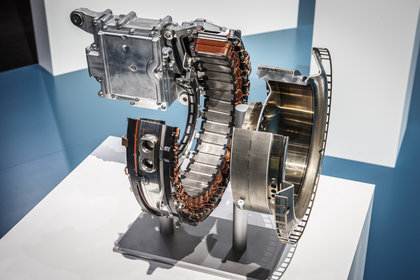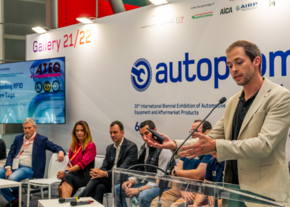
27/02/2017
Evolving automotive technology: what changes are in store for the Aftermarket?
Nicodemo Angì
Several manufacturers have already developed highly innovative and hybrid solutions designed to increase efficiency. Completing the picture, the 48V power supply revolution. A new technical horizon that specialists must learn to face within a few years.
As technology advances and new solutions are created, driven by the need to increase efficiency and reduce fuel consumption and emissions, these will inevitably affect the aftermarket sector. The constant development of internal combustion engines is important because it contributes greatly in reducing fuel consumption and harmful emissions and is relegating hybrid and electric vehicles to a marginal role on the market.
Now let us take a look at a few new engines recently introduced by three premium global brands. Let's start from the smallest of them: we are looking at a 3 and 4 cylinder petrol engine, called Firefly and they represent FCA’s modular proposal: three cylinders /1 liter and 4-cylinder /1.3 liters; the initial versions are 2-valves aspirated engines but soon enough a 4-valves turbocharged range will also hit the market. The Firefly’s long stroke improves torque (the longer intake manifolds have the same function) and the rather high compression ratio (13.2) increases efficiency and works on a modified Atkinson Cycle achieved through a variable valve timing system. Further friction reducing strategies include a roller rocker and an oil pump with variable flow rate while the axis of the cylinders is slightly offset compared to the crankshaft; the 4-cylinder version will have a smart-charging alternator-starter.
Greater in size but still committed to maximum efficiency is the new naturally aspirated 2.5 liter Toyota power unit: the "high speed" combustion cycle with variable valve timing scores record breaking thermal efficiency: 40% and 41% in the hybrid version. Here too, we find a long stroke and a compression ratio of 13 that increases to 14 in the hybrid version; efficiency is further guaranteed by long and smooth intake manifolds, wide valve angles, new injectors and a more efficient Air/Fuel mixture. The EGR system is cooled to prevent self-ignition, and on-board services are very efficient indeed: water pump and thermostat are electric and the oil pump can boast a variable flow rate.
Much more radical instead, is Mercedes’ solution. Its new turbo-charged M256, is a 3-liter 6-cylinder in-line capable of developing 400 hp and 500 Nm. Some of the expedients introduced increase combustion efficiency, but the real revolution , what makes this new engine “truly new” and therefore requiring new mechatronic skills, is in its service devices. The greater hybrid touch allowed Benz engineers to eliminate the Poly-V belt, which guarantees less power losses and shortened the unit to the same length of a V6 of equal displacement. Not just the water pump is electrically powered, but also two compressors: one is the A/C compressor while the other is an electric charger that, alongside the more traditional turbocharger promises to reduce turbo-lag as never before.
These devices are “power hungry” indeed, and here is where the 48V power supply comes into play. Multiplying by a factor of 4 the power supply voltage allows to reduce to a quarter, for the same power, the electrical current flowing, reducing losses and the section (not to mention weight and dimensions) of the conductor cables.
This soft-hybrid system allows to easily manage power-using devices, such as compressors, which absorb several kW, with many advantages on performance and efficiency. The power supply of the 48 V system has been entrusted to an unusual component, the Integrated Starter-Alternator, an "electric unit" keyed directly onto the engine shaft. The ISG acts as a starter motor (the Start & Stop system is guaranteed to be extremely subtle), and regenerates energy during braking and "helps" the internal combustion engine with a boost of 15 kW and 220 Nm, thus optimizing operating conditions with further efficiency gains.
The ISG is a new component which appears to have been designed, at this stage, for premium cars, but more down to earth applications are in the pipeline. The mild hybrid system created by the 48 volts will arrive in fact, in the form of a simplified belt-driven alternator-starter-motor also for small and medium-sized car as the system isn’t too complicated and can be integrated, with an inverter that acts as an interface, to a traditional 12 V system.
Workshops and professionals will have to be prepared to deal with these new components as well as electric compressors: the 48 V here are not as dangerous as the 300/400 volts normally found on electric vehicles but they still imply a different service and maintenance approach. It is also interesting to know that Magneti Marelli and Bosch are already well ahead in this field and thus their service networks will shortly receive dedicated training programs. Additionally, also Valeo, Delphi and Continental are currently studying 48 volt components, which means that specialists will need to start upgrading soon and be willing to open up to these new automotive solutions.
Now let us take a look at a few new engines recently introduced by three premium global brands. Let's start from the smallest of them: we are looking at a 3 and 4 cylinder petrol engine, called Firefly and they represent FCA’s modular proposal: three cylinders /1 liter and 4-cylinder /1.3 liters; the initial versions are 2-valves aspirated engines but soon enough a 4-valves turbocharged range will also hit the market. The Firefly’s long stroke improves torque (the longer intake manifolds have the same function) and the rather high compression ratio (13.2) increases efficiency and works on a modified Atkinson Cycle achieved through a variable valve timing system. Further friction reducing strategies include a roller rocker and an oil pump with variable flow rate while the axis of the cylinders is slightly offset compared to the crankshaft; the 4-cylinder version will have a smart-charging alternator-starter.
Greater in size but still committed to maximum efficiency is the new naturally aspirated 2.5 liter Toyota power unit: the "high speed" combustion cycle with variable valve timing scores record breaking thermal efficiency: 40% and 41% in the hybrid version. Here too, we find a long stroke and a compression ratio of 13 that increases to 14 in the hybrid version; efficiency is further guaranteed by long and smooth intake manifolds, wide valve angles, new injectors and a more efficient Air/Fuel mixture. The EGR system is cooled to prevent self-ignition, and on-board services are very efficient indeed: water pump and thermostat are electric and the oil pump can boast a variable flow rate.
Much more radical instead, is Mercedes’ solution. Its new turbo-charged M256, is a 3-liter 6-cylinder in-line capable of developing 400 hp and 500 Nm. Some of the expedients introduced increase combustion efficiency, but the real revolution , what makes this new engine “truly new” and therefore requiring new mechatronic skills, is in its service devices. The greater hybrid touch allowed Benz engineers to eliminate the Poly-V belt, which guarantees less power losses and shortened the unit to the same length of a V6 of equal displacement. Not just the water pump is electrically powered, but also two compressors: one is the A/C compressor while the other is an electric charger that, alongside the more traditional turbocharger promises to reduce turbo-lag as never before.
These devices are “power hungry” indeed, and here is where the 48V power supply comes into play. Multiplying by a factor of 4 the power supply voltage allows to reduce to a quarter, for the same power, the electrical current flowing, reducing losses and the section (not to mention weight and dimensions) of the conductor cables.
This soft-hybrid system allows to easily manage power-using devices, such as compressors, which absorb several kW, with many advantages on performance and efficiency. The power supply of the 48 V system has been entrusted to an unusual component, the Integrated Starter-Alternator, an "electric unit" keyed directly onto the engine shaft. The ISG acts as a starter motor (the Start & Stop system is guaranteed to be extremely subtle), and regenerates energy during braking and "helps" the internal combustion engine with a boost of 15 kW and 220 Nm, thus optimizing operating conditions with further efficiency gains.
The ISG is a new component which appears to have been designed, at this stage, for premium cars, but more down to earth applications are in the pipeline. The mild hybrid system created by the 48 volts will arrive in fact, in the form of a simplified belt-driven alternator-starter-motor also for small and medium-sized car as the system isn’t too complicated and can be integrated, with an inverter that acts as an interface, to a traditional 12 V system.
Workshops and professionals will have to be prepared to deal with these new components as well as electric compressors: the 48 V here are not as dangerous as the 300/400 volts normally found on electric vehicles but they still imply a different service and maintenance approach. It is also interesting to know that Magneti Marelli and Bosch are already well ahead in this field and thus their service networks will shortly receive dedicated training programs. Additionally, also Valeo, Delphi and Continental are currently studying 48 volt components, which means that specialists will need to start upgrading soon and be willing to open up to these new automotive solutions.






